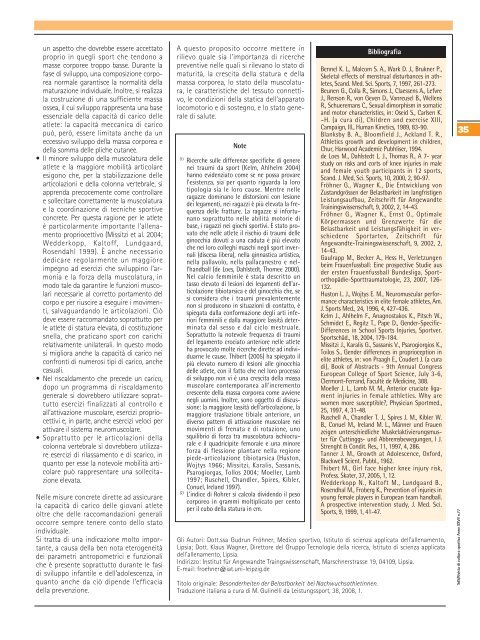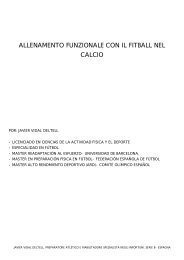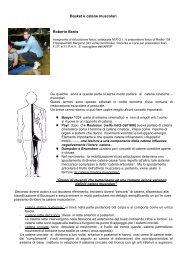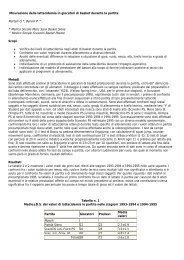Le capacità di carico delle giovani atlete - Preparazione Atletica
Le capacità di carico delle giovani atlete - Preparazione Atletica
Le capacità di carico delle giovani atlete - Preparazione Atletica
Create successful ePaper yourself
Turn your PDF publications into a flip-book with our unique Google optimized e-Paper software.
un aspetto che dovrebbe essere accettato<br />
proprio in quegli sport che tendono a<br />
masse corporee troppo basse. Durante la<br />
fase <strong>di</strong> sviluppo, una composizione corporea<br />
normale garantisce la normalità della<br />
maturazione in<strong>di</strong>viduale. Inoltre, si realizza<br />
la costruzione <strong>di</strong> una sufficiente massa<br />
ossea, il cui sviluppo rappresenta una base<br />
essenziale della <strong>capacità</strong> <strong>di</strong> <strong>carico</strong> <strong>delle</strong><br />
<strong>atlete</strong>: la <strong>capacità</strong> meccanica <strong>di</strong> <strong>carico</strong><br />
può, però, essere limitata anche da un<br />
eccessivo sviluppo della massa corporea e<br />
della somma <strong>delle</strong> pliche cutanee.<br />
• Il minore sviluppo della muscolatura <strong>delle</strong><br />
<strong>atlete</strong> e la maggiore mobilità articolare<br />
esigono che, per la stabilizzazione <strong>delle</strong><br />
articolazioni e della colonna vertebrale, si<br />
apprenda precocemente come controllare<br />
e sollecitare correttamente la muscolatura<br />
e la coor<strong>di</strong>nazione <strong>di</strong> tecniche sportive<br />
concrete. Per questa ragione per le <strong>atlete</strong><br />
è particolarmente importante l’allenamento<br />
propriocettivo (Missitzi et al. 2004;<br />
Wedderkopp, Kaltoff, Lundgaard,<br />
Rosendahl 1999). È anche necessario<br />
de<strong>di</strong>care regolarmente un maggiore<br />
impegno ad esercizi che sviluppino l’armonia<br />
e la forza della muscolatura, in<br />
modo tale da garantire le funzioni muscolari<br />
necessarie al corretto portamento del<br />
corpo e per riuscire a eseguire i movimenti,<br />
salvaguardando le articolazioni. Ciò<br />
deve essere raccomandato soprattutto per<br />
le <strong>atlete</strong> <strong>di</strong> statura elevata, <strong>di</strong> costituzione<br />
snella, che praticano sport con carichi<br />
relativamente unilaterali. In questo modo<br />
si migliora anche la <strong>capacità</strong> <strong>di</strong> <strong>carico</strong> nei<br />
confronti <strong>di</strong> numerosi tipi <strong>di</strong> <strong>carico</strong>, anche<br />
casuali.<br />
• Nel riscaldamento che precede un <strong>carico</strong>,<br />
dopo un programma <strong>di</strong> riscaldamento<br />
generale si dovrebbero utilizzare soprattutto<br />
esercizi finalizzati al controllo e<br />
all’attivazione muscolare, esercizi propriocettivi<br />
e, in parte, anche esercizi veloci per<br />
attivare il sistema neuromuscolare.<br />
• Soprattutto per le articolazioni della<br />
colonna vertebrale si dovrebbero utilizzare<br />
esercizi <strong>di</strong> rilassamento e <strong>di</strong> s<strong>carico</strong>, in<br />
quanto per esse la notevole mobilità articolare<br />
può rappresentare una sollecitazione<br />
elevata.<br />
Nelle misure concrete <strong>di</strong>rette ad assicurare<br />
la <strong>capacità</strong> <strong>di</strong> <strong>carico</strong> <strong>delle</strong> <strong>giovani</strong> <strong>atlete</strong><br />
oltre che <strong>delle</strong> raccomandazioni generali<br />
occorre sempre tenere conto dello stato<br />
in<strong>di</strong>viduale.<br />
Si tratta <strong>di</strong> una in<strong>di</strong>cazione molto importante,<br />
a causa della ben nota eterogeneità<br />
dei parametri antropometrici e funzionali<br />
che è presente soprattutto durante le fasi<br />
<strong>di</strong> sviluppo infantile e dell’adolescenza, in<br />
quanto anche da ciò <strong>di</strong>pende l’efficacia<br />
della prevenzione.<br />
A questo proposito occorre mettere in<br />
rilievo quale sia l’importanza <strong>di</strong> ricerche<br />
preventive nelle quali si rilevano lo stato <strong>di</strong><br />
maturità, la crescita della statura e della<br />
massa corporea, lo stato della muscolatura,<br />
le caratteristiche del tessuto connettivo,<br />
le con<strong>di</strong>zioni della statica dell’apparato<br />
locomotorio e <strong>di</strong> sostegno, e lo stato generale<br />
<strong>di</strong> salute.<br />
Note<br />
(1) Ricerche sulle <strong>di</strong>fferenze specifiche <strong>di</strong> genere<br />
nei traumi da sport (Kelm, Ahlhelm 2004)<br />
hanno evidenziato come se ne possa provare<br />
l’esistenza, sia per quanto riguarda la loro<br />
tipologia sia le loro cause. Mentre nelle<br />
ragazze dominano le <strong>di</strong>storsioni con lesione<br />
dei legamenti, nei ragazzi è più elevata la frequenza<br />
<strong>delle</strong> fratture. La ragazze si infortunano<br />
soprattutto nelle abilità motorie <strong>di</strong><br />
base, i ragazzi nei giochi sportivi. È stato provato<br />
che nelle <strong>atlete</strong> il rischio <strong>di</strong> traumi <strong>delle</strong><br />
ginocchia dovuti a una caduta è più elevato<br />
che nei loro colleghi maschi negli sport invernali<br />
(<strong>di</strong>scesa libera), nella ginnastica artistica,<br />
nella pallavolo, nella pallacanestro e nell’handball<br />
(de Loes, Dahlstedt, Thomee 2000).<br />
Nel calcio femminile è stata descritto un<br />
tasso elevato <strong>di</strong> lesioni dei legamenti dell’articolazione<br />
tibiotarsica e del ginocchia che, se<br />
si considera che i traumi prevalentemente<br />
non si producono in situazioni <strong>di</strong> contatto, è<br />
spiegata dalla conformazione degli arti inferiori<br />
femminili e dalla maggiore lassità determinata<br />
dal sesso e dal ciclo mestruale.<br />
Soprattutto la notevole frequenza <strong>di</strong> traumi<br />
del legamento crociato anteriore nelle <strong>atlete</strong><br />
ha provocato molte ricerche <strong>di</strong>rette ad in<strong>di</strong>viduarne<br />
le cause. Thibert (2005) ha spiegato il<br />
più elevato numero <strong>di</strong> lesioni alle ginocchia<br />
<strong>delle</strong> <strong>atlete</strong>, con il fatto che nel loro processo<br />
<strong>di</strong> sviluppo non vi è una crescita della massa<br />
muscolare contemporanea all’incremento<br />
crescente della massa corporea come avviene<br />
negli uomini. Inoltre, sono oggetto <strong>di</strong> <strong>di</strong>scussione:<br />
la maggiore lassità dell’articolazione, la<br />
maggiore traslazione tibiale anteriore, un<br />
<strong>di</strong>verso pattern <strong>di</strong> attivazione muscolare nei<br />
movimenti <strong>di</strong> frenata e <strong>di</strong> rotazione, uno<br />
squilibrio <strong>di</strong> forza tra muscolatura ischiocrurale<br />
e il quadricipite femorale e una minore<br />
forza <strong>di</strong> flessione plantare nella regione<br />
piede-articolazione tibiotarsica (Huston,<br />
Wojtys 1966; Missitzi, Karalis, Sassanis,<br />
Psarogiorgas, Tollos 2004; Moeller, Lamb<br />
1997; Ruschell, Chandler, Spires, Kibler,<br />
Conuel, Ireland 1997).<br />
(2) L’in<strong>di</strong>ce <strong>di</strong> Rohrer si calcola <strong>di</strong>videndo il peso<br />
corporeo in grammi moltiplicato per cento<br />
per il cubo della statura in cm.<br />
Bibliografia<br />
Bennel K. L., Malcom S. A., Wark D. J., Brukner P.,<br />
Skeletal effects of menstrual <strong>di</strong>sturbances in athletes,<br />
Scand. Med. Sci. Sports, 7, 1997, 261-273.<br />
Beunen G., Colla R., Simons J., Claessens A., <strong>Le</strong>fvre<br />
J., Renson R., von Geven D., Vanreusel B., Wellens<br />
R., Schueremans C., Sexual <strong>di</strong>morphism in somatic<br />
and motor characteristics, in: Oseid S., Carlsen K.<br />
–H. (a cura <strong>di</strong>), Children and exercise XIII,<br />
Campaign, Ill., Human Kinetics, 1989, 83-90.<br />
Blanksby B. A., Bloomfield J., Ackland T. R.,<br />
Athletics growth and development in children,<br />
Chur, Harwood Academic Pubhliser, 1994.<br />
de Loes M., Dahlstedt L. J., Thomas R., A 7- year<br />
study on risks and corts of knee injuries in male<br />
and female youth participants in 12 sports,<br />
Scand. J. Med, Sci. Sports, 10, 2000, 2, 90-97.<br />
Fröhner G., Wagner K., Die Entwicklung von<br />
Zustandgrössen der Belastbarkeit im langfristigen<br />
<strong>Le</strong>istungsaufbau, Zeitschrift für Angewandte<br />
Trainingswissenschaft, 9, 2002, 2, 14-43.<br />
Fröhner G., Wagner K., Ernst O., Optimale<br />
Körpermassen und Grenzwerte für <strong>di</strong>e<br />
Belastbarkeit und <strong>Le</strong>istungsfähigkeit in verschiedene<br />
Sportarten, Zeitschrift für<br />
Angewandte-Trainingswissenschaft, 9, 2002, 2,<br />
14-43.<br />
Gaulrapp M., Becker A., Hess H., Verletzungen<br />
beim Frauenfussball: Eine prospective Stu<strong>di</strong>e aus<br />
der ersten Frauenfussball Bundesliga, Sportorthopä<strong>di</strong>e-Sporttraumatologie,<br />
23, 2007, 126-<br />
132.<br />
Huston L. J., Wojtys E. M., Neuromuscular performance<br />
characteristics in elite female athletes, Am.<br />
J. Sports Med., 24, 1996, 4, 427-436.<br />
Kelm J., Ahlhelm F., Anagnostakos K., Pitsch W.,<br />
Schmidet E., Regitz T., Pape D., Gender-Specific-<br />
Differences in School Sports Injuries, Sportver.<br />
Sportschäd., 18, 2004, 179-184.<br />
Missitzi J., Karalis G., Sassanis V., Psarogiorgios K.,<br />
Toilos S., Gender <strong>di</strong>fferences in proprioception in<br />
elite athletes, in: von Praagh E., Coudert J. (a cura<br />
<strong>di</strong>), Book of Abstracts - 9th Annual Congress<br />
European College of Sport Science, July 3-6,<br />
Clermont-Ferrand, Facultè de Me<strong>di</strong>cine, 388.<br />
Moeller J. L., Lamb M. M., Anterior cruciate ligament<br />
injiuries in female athletics. Why are<br />
women more susceptible?, Physician Sportmed.,<br />
25, 1997, 4, 31-48.<br />
Ruschell A., Chandler T. J., Spires J. M., Kibler W.<br />
B., Conuel M., Ireland M. L., Männer und Frauen<br />
zeigen unterschiedliche Muskelaktivierungsmuster<br />
für Cuttinggs- und Abbremsbewegungen, I J.<br />
Strenght & Con<strong>di</strong>t. Res., 11, 1997, 4, 286.<br />
Tanner J. M., Growth at Adolescence, Oxford,<br />
Blackwell Scient. Pubbl., 1962.<br />
Thibert M., Girl face higher knee injury risk,<br />
Profess. Skater, 37, 2005, 1, 12.<br />
Wedderkopp N., Kaltoft M., Lundgaard B.,<br />
Rosendhal M., Froberg K., Prevention of injuries in<br />
young female players in European team handball.<br />
A prospective intervention study, J. Med. Sci.<br />
Sports, 9, 1999, 1, 41-47.<br />
Gli Autori: Dott.ssa Gudrun Fröhner, Me<strong>di</strong>co sportivo, Istituto <strong>di</strong> scienza applicata dell’allenamento,<br />
Lipsia; Dott. Klaus Wagner, Direttore del Gruppo Tecnologie della ricerca, Istituto <strong>di</strong> scienza applicata<br />
dell’allenamento, Lipsia.<br />
In<strong>di</strong>rizzo: Institut für Angewandte Traingswissenschaft, Marschnerstrasse 19, 04109, Lipsia.<br />
E-mail: froehner@iat.uni-leipzig.de<br />
Titolo originale: Besonderheiten der Belastbarkeit bei Nachwuchsathletinnen.<br />
Traduzione italiana a cura <strong>di</strong> M. Gulinelli da <strong>Le</strong>istungssport, 38, 2008, 1.<br />
SdS/Rivista <strong>di</strong> cultura sportiva Anno XXVII n.77 35






